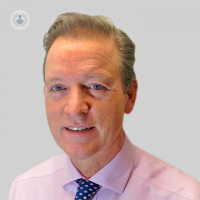Therapeutic mammoplasty: what are the possible complications of surgery?
Autore:If you and your oncoplastic breast surgeon have opted for therapeutic mammoplasty as the surgical procedure to treat your breast cancer, you may be wondering what the possible complications are with the operation. One of our expert consultants Mr Brendan Smith outlays everything that you need to know when it comes to therapeutic mammoplasty and the risks of surgery.

Are there any complications to having surgery?
All surgery carries some element of risk but the general complications include:
- Haematoma - bleeding into the tissues following surgery and can occasionally lead to patients returning to the theatre to stop the bleeding and remove the blood (3-4 in every 100 women).
- Wound infection - which can occur after any type of surgery and may need treatment with antibiotics.
- Deep venous thrombosis (DVT)/pulmonary embolism - this can happen after any operation and general anaesthetic. Risks are reduced by wearing preventative stockings and giving an anti-clotting injection in certain cases.
What are the specific risks of therapeutic mammoplasty?
Here I outline the potential risks related specifically to therapeutic mammoplasty. They include:
Re-excision (need for further surgery)
If we are unable to get a clear margin of normal tissue around the lump then further surgery will be required on your breast. This accounts for 20% (or 2 in 10) of cases nationally for a routine lumpectomy. We will not know this until you have a consultation with your results between one to two weeks later. If this is needed it can sometimes be done through the same incision, as a day case and performed within four weeks but other times a mastectomy may be advised.
Delayed wound healing (T-junction necrosis)
The blood supply at the point where the vertical scar meets the horizontal scar (the T-junction) is the poorest and this area is vulnerable. The skin may fail to heal initially and will separate leaving a raw area. This is occasionally extensive, requiring regular dressings for several months until the wound is fully healed. This is more common in therapeutic mammoplasty if the tumour lies close to the skin. Delayed healing can occur in 3 – 5% (between 3 and 5 cases out of every 100).
Nipple complications
The operation by its nature partially disrupts the blood supply to the nipple. There is a small but definite risk of nipple loss from this type of surgery, either total or partial (less than 1% or 1 in 100 cases). The risk is greater the closer the tumour is to the nipple. Loss of, or altered, nipple sensation is a more common complication seen in 30-50% of patients. This may be a temporary or permanent symptom.
Asymmetry
There may be some lasting differences in the size and shape of your breasts following surgery, which may be significant. You may desire the breast on the other side to be reduced to provide a good match in size and shape. This wouldn’t normally be done until at least six months after radiotherapy if it was required.
Scarring
Initially, the scars will be fine and appear as bright red lines. In most cases, the scars will usually heal satisfactorily and soften, becoming much paler and less obvious after 12 months or so. Some patients have a tendency to form red and lumpy scars (hypertrophy) or keloid scars, which are broad raised scars. The scarring will be permanent.
Fat necrosis
This is a common complication with this type of surgery due to interruption to the delicate blood supply of the fatty tissue within the breast. Occasionally, this fat dissolves and turns into a yellow, oily fluid that can leak through the wound closure. It more commonly results in a lump or hard nodular areas within the breast and may occur several months after surgery. Any breast lumps found should be checked with your GP and/or mentioned at your follow-up appointment.
READ MORE ON WHO IS SUITABLE FOR THERAPEUTIC MAMMOPLASTY
If you would like to discuss your surgical options for breast cancer you can book an appointment with Mr Smith via his Top Doctor’s profile here for his expert opinion.


